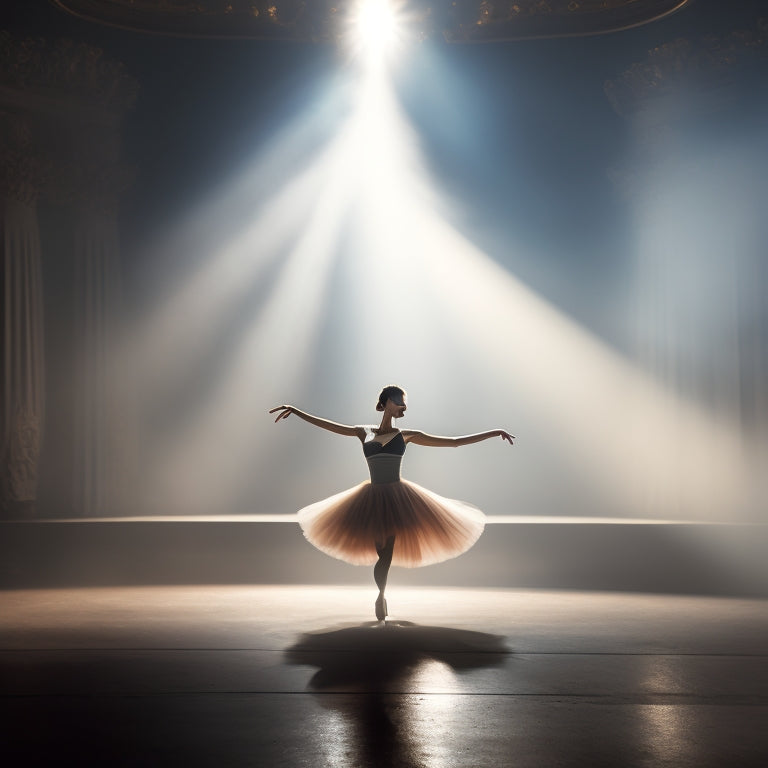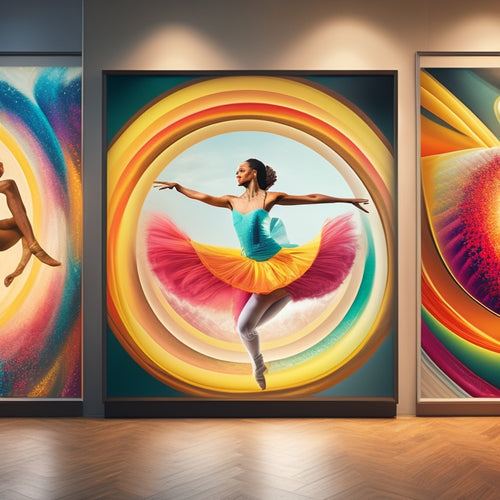
Mastering the Art of Dance Performance
Share
Mastering the art of dance performance requires a deliberate synergy of technical skill, mental toughness, and strategic preparation, culminating in a mesmerizing stage presence that leaves a lasting impression on the audience. A holistic approach involves essential pre-performance preparation, including timely arrival, nutrition regimens, and visualization techniques. Effective rehearsal strategies, such as weekly technique classes and run-throughs, refine skills and build confidence. By managing performance day jitters through breathing techniques, visualization, and positive self-talk, dancers can transform anxiety into focused energy. By integrating these elements, a dancer can tap into their full potential and deliver a spellbinding performance. Further refinement of these skills awaits.
Key Takeaways
• Pre-performance preparation is key, including a thorough checklist, timely arrival, and a nutrition regimen that fuels the body.
• Regular technique classes, rehearsals with music, and run-throughs help refine skills, build confidence, and master choreography.
• Visualization techniques, deep breathing, and positive self-talk can help manage performance anxiety and focus the mind.
• Incorporating mental preparation strategies, such as focusing on technique and synchronization, can enhance overall performance.
• A holistic approach that combines physical preparation, mental focus, and stress management techniques is essential for mastering the art of dance performance.
Pre-Performance Preparation Essentials
To guarantee a flawless performance, a dancer's pre-performance preparation is essential, involving a meticulous checklist of essential items and a timely arrival at the venue.
A well-planned nutrition regimen is critical, with healthy, light meals and hydration to promote peak energy levels. Nutrition tips include consuming complex carbohydrates, lean proteins, and avoiding heavy meals before the show.
Visualization techniques can also enhance performance, where dancers mentally rehearse their routines, perfecting every step and movement.
By incorporating these preparation essentials, dancers can minimize stress and maximize their performance potential.
A thorough checklist and timely arrival ensure a smooth and confident progression to the stage, setting the tone for an engaging performance.
Rehearsal Strategies for Success
Effective rehearsal strategies, comprising weekly technique classes, rehearsals, and run-throughs, form the backbone of a successful dance performance, as they enable dancers to refine their skills, master choreography, and develop the necessary confidence to take the stage.
| Rehearsal Strategy | Benefits |
|---|---|
| Weekly Technique Classes | Refine skills, improve flexibility and strength |
| Rehearsals with Music | Master choreography, develop muscle memory |
| Run-throughs | Build confidence, simulate stage experience |
| Group Rehearsals | Foster team dynamics, encourage constructive feedback |
| Mental Preparation | Focus on technique, synchronization, and positive self-talk |
Managing Performance Day Jitters
As the curtain rises, dancers often experience a surge of anxiety, which, if left unchecked, can compromise their performance, making it essential to develop strategies for managing performance day jitters.
To combat this, dancers can employ breathing techniques, such as deep, controlled inhales and exhales, to calm the nervous system. Visualization exercises can also help, where dancers mentally rehearse their performance, focusing on precise movements and execution.
Additionally, important self-talk and mental focus are vital, as dancers can reframe their thoughts to emphasize confidence and capability. By incorporating these strategies, dancers can transform their performance anxiety into focused energy, resulting in a more polished and captivating performance.
Frequently Asked Questions
How Can I Improve My Stage Presence and Connect With the Audience?
To captivate the audience, ignite your inner spark: exude confidence, forge an emotional connection, and radiate dynamic energy. Access stage charisma through authentic performances, fostering audience engagement and leaving a lasting impression.
What Are Some Tips for Remembering Choreography Under Pressure?
To recall choreography under pressure, employ mental tricks like visualization and positive self-talk, and practice strategies such as repetition, chunking, and spaced repetition to solidify muscle memory and boost confidence.
How Do I Handle Criticism or Negative Feedback From Instructors?
When receiving criticism, cultivate a growth mindset by embracing constructive critique, developing thick skin, and reframing negative feedback as opportunities for growth, allowing you to refine your craft and emerge stronger, more resilient, and refined.
Can I Still Perform if I Have an Injury or Illness on Show Day?
'Despite initial concerns, it's essential to prioritize health: if injured or ill on show day, adhere to Injury Protocol, employing Contingency Planning to guarantee a seamless performance, safeguarding both dancer and production.'
How Do I Balance Dance With Other Responsibilities, Like School or Work?
To balance dance with other responsibilities, employ effective time management by prioritizing tasks, optimizing schedules, and allocating realistic time blocks for each commitment, ensuring seamless integration of dance with school or work obligations.
Related Posts
-

Wireless Bluetooth Speakers With the Longest Battery Life
If you're in the market for wireless Bluetooth speakers with the longest battery life, look for models boasting over ...
-

Budget-Friendly Tips for Printing Wedding Photobooks
To create a stunning wedding photobook on a budget, consider cost-effective printing options such as digital printing...
-

Dancers Delight: Stylish Wall Prints Available Now
Dancers Delight offers a curated collection of stylish wall prints that capture the essence of ballet, tap, and jazz,...


